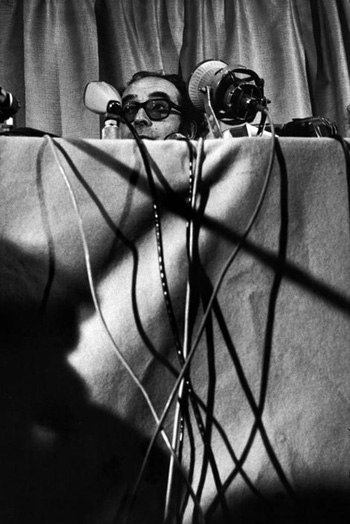Introducing the 75th issue of Senses of Cinema, editor Rolando Caputo announces that he’s decided “to call time on my tenure with the journal. All good things come to end, and after close to a decade’s involvement with Senses it feels like the right time to move on to other endeavors.” And of course, we wish him all the best.
The big surprise of Senses 75 is the extensive dossier on Michael Bay, “a filmmaker of growing fascination to scholars interested in charting the emergence of a spectacular, special effects driven cinema in the digital age,” notes Caputo.
Jean-Luc Godard also figures rather prominently in this issue. Along with Yvette Biro‘s consideration of Adieu au langage, there’s Tony Hildebrandt‘s review of Farocki/Godard: Film as Theory, in which Volker Pantenburg “sheds light on the manner in which Godard and Farocki both succeeded, with their critical work on the image, in developing comparable practices and artefacts which transcend classical generic boundaries.”
And Michael Cramer reviews Introduction to a True History of Cinema and Television, “a faithful, unrevised record of the talks” JLG delivered between April and October 1978 at Concordia University’s Conservatory of Cinematographic Art, translated and edited by Timothy Barnard.
Here, we need to slip a link in to Michael Witt‘s article in the new issue of NECSUS: European Journal of Media Studies because he notes that this series of lectures in Montreal is the “most direct antecedent” to “a little-known experimental compilation film that Jean-Luc Godard constructed and showed within the framework of a series of lectures on cinema history that he delivered in Rotterdam in 1980-1981.”
Witt, who’s written the introduction to Introduction, has been doing some serious detective work on Sauve la vie (qui peut), a “special edition” of Sauve qui peut (la vie) (Every Man for Himself, 1980) comprised of sections of his original film and extracts from Sergei Eisenstein and Grigori Alexandrov’s Old and New (1929), Edward Kline and Buster Keaton‘s Cops (1922), Luchino Visconti‘s La terra trema (1948) and Andrzej Wajda‘s Man of Marble (1977).
Back to Senses—and more book reviews:
- Geoff Garnder on The Essential Raymond Durgnat, edited by Henry K. Miller.
- Tony McKibbin on André Bazin’s New Media, edited by Dudley Andrew.
- Luca Peretti on Joseph Luzzi’s A Cinema of Poetry: Aesthetics of the Italian Art Film.
- David Ritchie on Dirk de Bruyn’s The Performance of Trauma in Moving Image Art.
- Nafis Shafizadeh on Peter Kramer’s Dr. Strangelove or: How I learned to Stop Worrying and Love the Bomb.
Interviews:
- Raphaël Bassan with Franco-Australian filmmakers Viviane Vagh and Jayne Amara Ross and Julia Gouin‘s interview with Bassan.
- Tom Ryan with the late Albert Maysles; see, too, Tim O’Farrell on Albert and David Maysles’s celebrity portrait films.
- From Cannes, Amir Ganjavie with Hou Hsiao-hsien (The Assassin) and Corneliu Porumboiu (The Treasure).
- Wheeler Winston Dixon with Denis Côté.
- Lydia Papadimitriou with Hubert Sauper.
The batch of Cinémathèque Annotations on Film features quite a few on films by Mikio Naruse: Mel Aguilar on When a Woman Ascends the Stairs (1960), Darragh O’Donoghue on Repast (1951), Adam Powell on Flowing (1956) and Luke Aspell on Mother (1952).
More annotations:
- Evgeny Gusyatinskiy on Kira Muratova’s The Asthenic Syndrome (1989) and Aaron Cutler on Muratova’s Getting to Know the Big Wide World (1978).
- Lauren Carroll Harris on Alfred Hitchcock’s Notorious (1946).
- David Melville on George Cukor’s Gaslight (1944).
- Christopher Weedman: “La Paura (Fear, 1954) is the final and arguably most underrated film collaboration between Ingrid Bergman and Roberto Rossellini.”
- Julian Murphy on Ingmar Bergman’s Autumn Sonata (1978).
- Shari Kizirian on Gustaf Molander’s Intermezzo (1936).
- Cerise Howard on Karel Zeman’s The Outrageous Baron Munchausen (1962) and A Jester’s Tale (1964) and Wheeler Winston Dixon on Zeman’s Invention of Destruction (1958).
Also in this issue: Moritz Pfeifer on Pawel Pawlikowski‘s Ida (2013) and Andrey Zvyagintsev‘s Leviathan (2014), Philip Cartelli on Bruno Dumont‘s P’tit Quinquin (2014) and the latest round of festival reports.
Catherine Grant alerts us to new issues from two journals. The first, from the afore-mentioned NECSUS, features her own Carnal Locomotive, a primer “on phenomenological film theory as well as a tribute to the works of René Clément, Henri Decae, Vivian Sobchack, Steven Shaviro and Claude Lévi-Strauss.” Cristina Álvarez López and Adrian Martin introduce it along with Philip Brophy’s Club Video: “As we argued in our introduction in the Autumn 2014 issue, there are many possible forms along the continuum between ‘explanatory’ and ‘poetic’ audiovisual essays. What we have curated this time around tends more to the ‘art’ than the ‘essay’ side of the form, and they also aim to provide the beginning of a historical perspective on the multiple developments in this area that bear upon present-day practice.”
Along with a special section on “Animals,” the Spring 2015 issue also features festivals reports, reviews of books and exhibitions and three more features. Laura Mulvey, Anna Backman Rogers and Annie van den Oever discuss Mulvey’s essay “Visual Pleasure and Narrative Cinema” 40 years after its publication; Jenifer Chao on the Canadian situation comedy series Little Mosque on the Prairie (2007-2012); and Lidia Merás and Sarah Wright on Michael Powell‘s Honeymoon (Luna de miel, 1959), “designed to be a ‘Spanish Red Shoes.'”
Two articles that catch my eye from the new issue of Participations: Journal of Audience & Receptions Studies: “Men watching Sex and the City, My Little Pony, and Oklahoma: The interpretation of gender appropriateness in the reception of cross-gendered media products” by CarrieLynn D. Reinhard and Kevin Miller and “Scott Pilgrim vs. the multimodal mash-up: Film as participatory narrative” by Amy C. Chambers and R. Lyle Skains.
For news and tips throughout the day every day, follow @KeyframeDaily. Get Keyframe Daily in your inbox by signing in at fandor.com/daily.




